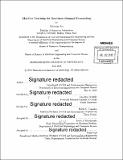| dc.contributor.advisor | Una-May O'Reilly. | en_US |
| dc.contributor.author | Xu, Runmin, S.M. Massachusetts Institute of Technology | en_US |
| dc.contributor.other | Massachusetts Institute of Technology. Department of Civil and Environmental Engineering. | en_US |
| dc.date.accessioned | 2015-10-30T18:55:54Z | |
| dc.date.available | 2015-10-30T18:55:54Z | |
| dc.date.copyright | 2015 | en_US |
| dc.date.issued | 2015 | en_US |
| dc.identifier.uri | http://hdl.handle.net/1721.1/99565 | |
| dc.description | Thesis: S.M., Massachusetts Institute of Technology, Department of Electrical Engineering and Computer Science, 2015. | en_US |
| dc.description | Thesis: S.M. in Transportation, Massachusetts Institute of Technology, Department of Civil and Environmental Engineering, 2015. | en_US |
| dc.description | Cataloged from PDF version of thesis. | en_US |
| dc.description | Includes bibliographical references (pages 89-92). | en_US |
| dc.description.abstract | For a taxi company, the capability to forecast taxi demand distribution in advance provides valuable decision supports. This thesis studies real-time forecasting system of spatiotemporal taxi demand based on machine learning approaches. Traditional researches usually examine a couple of candidate models by setting up an evaluation metric and testing the overall forecasting performance of each model, finally the best model is selected. However, the best model might be changing from time to time, since the taxi demand patterns are sensitive to the dynamic factors such as date, time, weather, events and so on. In this thesis, we first study range searching techniques and their applications to taxi data modeling as a foundation for further research. Then we discuss machine learning approaches to forecast taxi demand, in which the pros and cons of each proposed candidate model are analyzed. Beyond single models, we build a five-phase ensemble estimator that makes several single models work together in order to improve the forecasting accuracy. Finally, all the forecasting approaches are evaluated in a case study over rich taxi records of New York City. Experiments are conducted to simulate the operation of real-time forecasting system. Results prove that multi-model ensemble estimators do produce better forecasting performances than single models. | en_US |
| dc.description.statementofresponsibility | by Runmin Xu. | en_US |
| dc.format.extent | 92 pages | en_US |
| dc.language.iso | eng | en_US |
| dc.publisher | Massachusetts Institute of Technology | en_US |
| dc.rights | M.I.T. theses are protected by copyright. They may be viewed from this source for any purpose, but reproduction or distribution in any format is prohibited without written permission. See provided URL for inquiries about permission. | en_US |
| dc.rights.uri | http://dspace.mit.edu/handle/1721.1/7582 | en_US |
| dc.subject | Electrical Engineering and Computer Science. | en_US |
| dc.subject | Civil and Environmental Engineering. | en_US |
| dc.title | Machine learning for real-time demand forecasting | en_US |
| dc.type | Thesis | en_US |
| dc.description.degree | S.M. | en_US |
| dc.description.degree | S.M. in Transportation | en_US |
| dc.contributor.department | Massachusetts Institute of Technology. Department of Civil and Environmental Engineering | |
| dc.contributor.department | Massachusetts Institute of Technology. Department of Electrical Engineering and Computer Science | |
| dc.identifier.oclc | 924315586 | en_US |
